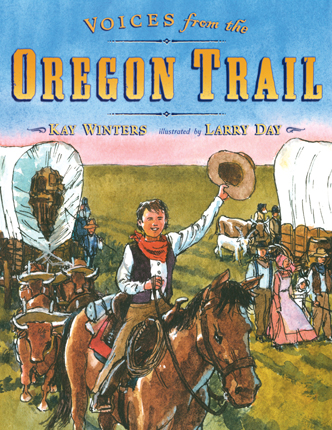Full Text Reviews: School Library Journal - 02/01/2014 Gr 3–6—Fifteen members of a wagon train share their thoughts and experiences on an 1848 journey from Independence, Missouri, to Oregon City. Preparations and anticipation, hopes and misgivings precede the reality of trail life. The wagon master's 13-year-old son, Carl, offers the first and last free-verse commentaries. Other young people and adults relate sorrows and joys along the way: a toddler's death, abandoned possessions to lighten the load, an Independence Day celebration, a wedding, a birth. Although some overlanders express fears of "savage" Indians, the only encounter is peaceful, with Nez Perce helping the travelers cross the Snake River and saving Carl from drowning. A Sioux scout observes the passing wagons and worries about the impact on his people. Day's paintings, particularly the spread of the entire wagon train, capture the panoramic prairie vistas and enhance the speakers' accounts. Detailed historical notes and a suggested reading list offer additional resources for readers and report writers. Without the unifying presence that the printer's errand boy supplied in Winters and Day's Colonial Voices (Dutton, 2008), the relationships among the speakers can get a bit tangled. However, the overall presentation of trail life offers another fine choice for students of history.—Kathy Piehl, Minnesota State University, Mankato - Copyright 2014 Publishers Weekly, Library Journal and/or School Library Journal used with permission. Booklist - 02/15/2014 As in Winters’ Colonial Voices (2008) and Voices of Ancient Egypt (2003), the 17 free-verse poems here represent the points of view of fictional people in the past. Set in 1848, this large-format collection leads off with 13-year-old Carl Hawks. Proud that his father will lead the wagon train from Independence, Missouri, to Oregon City, Carl also worries, wondering what they will face along the Oregon Trail and who will survive. Usually the verse gives voice to one of the wagon train travelers, including two mothers whose children have died. In one poem, a Sioux scout expresses his misgivings about the many settlers moving through the land. Each poem appears on a double-page spread along with a colorful illustration done in pencil, ink, watercolor, and gouache. Full of historical details, these attractive pictures will help students imagine the period setting. The endpapers include portraits of individuals as well as a map of the travelers’ route. Useful mainly as an adjunct to the curriculum, the book offers a ready-made opportunity for readers’ theater. - Copyright 2014 Booklist. Loading...
|



